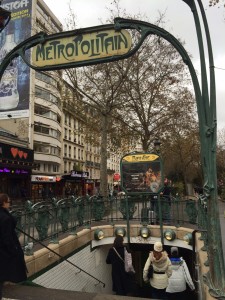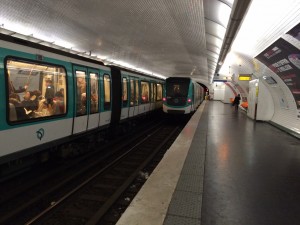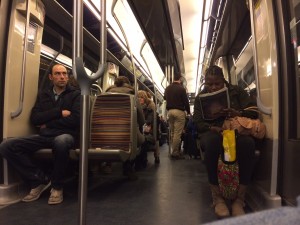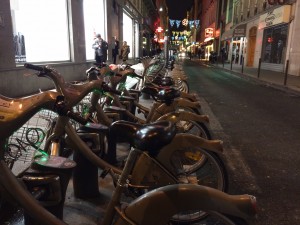 Jon Carroll of the San Francisco Chronicle appears to have been in Paris around the time I was last month, and he also rode the Metro (the City of Lights is on my mind today after the brutal murders there). Like me, Carroll is taken by the convenience of the system:
Jon Carroll of the San Francisco Chronicle appears to have been in Paris around the time I was last month, and he also rode the Metro (the City of Lights is on my mind today after the brutal murders there). Like me, Carroll is taken by the convenience of the system:
I love the Metro’s Stygian tunnels and the endless tile work. I love the utter predictability of it; a transit system you can take for granted. I think: Wouldn’t it be nice to have real rapid transit like that?
Imagine San Francisco crisscrossed by subways. Imagine stations close together, so everyone’s neighborhood is served. Imagine a system like that running 24 hours a day, almost always safe, sleepy at night and pulsing in the late afternoon. Imagine what a contribution to public spaces that would make.
And like me, he realizes this is an infrastructure system that could only have been built a century ago:
But no way that is happening now. We’re not building infrastructure anymore, beyond some political monuments characterized mostly by cost overruns. Paris’ first Metro line opened in 1900; the whole thing, all 133 miles of it, was finished a quarter of a century later. Back then, they thought building cool stuff was a positive cultural phenomenon, but that hasn’t been true for half a century now.
Carroll’s piece reminded me of another convenience in the Paris Metro: live human beings at information desks to help you navigate the system. BART and some other rail systems have such a feature (if you consider station agents true information helpers, which they aren’t always — at least in my experience). But the number and helpfulness of these information officers, particularly for a confused tourist like me, was much appreciated.
Meanwhile, my thoughts are with the residents of that beautiful city today.
Paris may be famous for food, art, history, and unparalleled urban beauty. But the city could also qualify as a transitopia, with some lessons for other urban regions. Before the holidays, I had the opportunity to travel to the city of lights for an Essec Business School conference on “electromobility.” I took the opportunity to scout out its transit system and came away impressed.
The backbone is the underground Paris Metro, opened with little fanfare in 1900. The 133 miles of rail includes 303 stations and 16 lines. Since the system stops every few blocks, it is ideal for serving the densely populated city center.
For longer trips, Paris built itself a longer-range suburban commuter rail line, called the “RER.” It’s fast and has stops spaced farther apart, which is badly needed since the Metro is focused on short-range trips.
Beyond those two city-focused systems, you’ve got long-distance trains and high speed rail to connect you all over Europe.
With the abundance of infrastructure and high-density living, rail travel is a way of life in Paris, and the numbers show it. Metro is the second-busiest subway system in Europe, with roughly 1.5 billion passengers each year and over 4 million per day. Indeed, traveling by Metro during peak hours is really uncomfortable. You have to let sometimes multiple trains pass in order to find space just to squeeze in the doors. Luckily the trains arrive in short order, but it’s unpleasant. Some kind of congestion pricing might be advisable to encourage more ridership in off-peak hours instead. Because they sure can’t build more capacity or increase headways.
Paris also has a comprehensive bus system, but the roads are so crowded and narrow in many places that rail offers some distinct advantages. Still, a partial ban on cars might greatly improve bus service, as the mayor of Paris is proposing (I understand it may be an effort to keep out non-Parisian drivers from the city streets).
Meanwhile, on the biker front, I didn’t see a lot of bicyclists (although winter might not be the best time for people to take out the bikes), but they have some green-striped bike lanes on many major roads. Not many were protected, at least that I saw. They also have a full-scale bikeshare program, similar to major cities in the US and elsewhere.
And there were plenty of pedestrians, although I don’t know how they don’t get hurt more often. Crossing streets in Paris is confusing and risky. In a number of places, they have walk signals for half the street, but then you get to a narrow curb in the middle and have to wait while the other walk signal turns green. It’s easy as a first-timer not to notice the second red signal when the first turns green and just keep walking — right into traffic.
Overall, getting around without a car in Paris is very easy, although slightly dangerous as a pedestrian. Most cities probably could not afford to build a comprehensive underground subway like Paris has (and maybe even Paris couldn’t these days, given how costs have increased so dramatically around the world). But the key for the city is the density of the development, with most buildings at about seven to eight stories, and a variety of transportation options, from short-range rail to commuter rail to bike lanes and pedestrian boulevards. So if you go to Paris, plan on transit for the rare times you don’t need to walk.
In a future post I’ll discuss electromobility options in France, which could provide a strong model for other cities around the world.





